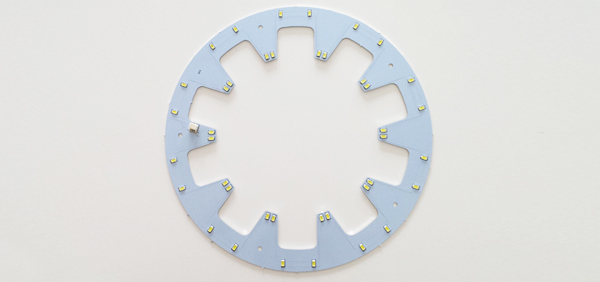Everything You Need to Know about Aluminum PCBs
Metal clad printed circuit boards are a cost effective solution and it offers greater performance and more power with today’s demanding applications. Also known as insulated metal substrate PCBs and thermally conductive PCBs, they utilize metals such as copper and aluminum as the base metal. Aluminum PCBs are not only lighter, but are also cheaper to produce.

How Are They Produced?
Metal substrate printed circuit boards are made by inserting and laminating a thin layer of a dielectric material between the metallic base and the copper foil. This dielectric does not conduct electrically, but it has a good thermal conductivity so as to conduct heat. The copper foil is embedded into the required pattern for the circuit. In the case of an aluminum PCB, the metal base is made of aluminum which conducts heat away from the circuit through the dielectric.
Benefits of Aluminum PCBs
There are quite a few advantages of using aluminum printed circuit boards.
- The dissipation of heat in aluminum is much better and far superior to standard FR4 material. When compared to Copper PCBs, aluminum PCBs offer better heat dissipation.
- In FR4 PCBs, the dielectrics are not thin and don’t offer a good thermal conductivity. On the other hand, the dielectric utilized in aluminum PCBs are one-tenth of the thickness and provide up to 5 to 6 times the thermal conductivity of epoxy glass.
- The thermal transfer exponent is more efficient than that of a rigid PCB.
- Since aluminum is around 70 percent lighter than copper, aluminum printed circuit boards are a better alternative to copper based printed circuit boards.
Applications
Aluminum based printed circuit boards are used in applications which involve LEDs, power converters, and radio frequency. They are even finding their way into automotive applications.
The Different Configurations
Single layered aluminum PCBs are common, but nowadays there are many new configurations and construction types being implemented.
- Flexible Aluminum based PCB: These PCBs use a dielectric which is flexible in nature; it consists of a polyimide resin mixed with ceramic. This configuration provides excellent flexibility, good electrical insulation, and a high level of thermal conductivity. It can be arranged into different angles and shapes, thereby eliminating the need to install costly connectors, fixtures, and cables.
- Hybrid PCBs: This type of PCB has a separate non-thermal material like FR4, bonded to an aluminum base. The construction is usually 2 layered or 4 layered. It dissipates heat faster, acts like a shield, and is very rigid. Other benefits include:
- Cheaper to make than other thermal conductive PCBs.
- Provides an enhanced performance over traditional FR4 board.
- No expensive heat sinks are required.
- Multilayer PCBs: They are utilized in high performance power supplies and are fabricated from multiple layers of dielectrics. They employ more than a single layer of circuitry, embedded within the dielectric. Furthermore, the blind vias are used as either the signal via or the thermal via. Overall, they provide a better heat dissipation factor in a complex design.
